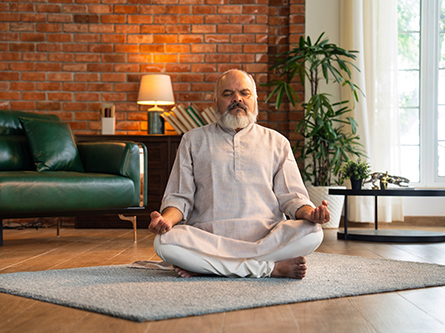Most of us have felt motion sickness at one point in our lives. It can happen any time your body is still but the vehicle you're in is moving.
There are things you can do to prevent symptoms of motion sickness so that you can enjoy your trip or activity.
Why does motion sickness happen?
The feeling of being motion sick happens when your eyes and your inner ear don't agree on what's happening – like whether you're moving or not. This can happen when you're sitting or standing still but the object you're in is moving. It can lead to dizziness, nausea, headache or sweating.
Where is motion sickness most likely to happen?
Motion sickness can happen in a variety of situations. Feeling seasick is the most common form. An interesting fact is that the word "nausea" is derived from the Greek word "naus" which means ship. Nausea means "ship sickness."
But motion sickness can happen to people traveling by car, bus and plane. And some people can get it from theme park rides. It can even happen to people who use virtual reality headsets.
In one survey of about 3,200 bus passengers in the U.K., 28% felt ill, 13% reported nausea and 2% vomited. Another study highlighted motion sickness experienced by passengers on commercial airline flights, finding that 24% felt ill or nauseated.
What is virtual motion sickness?
Virtual motion sickness, or cybersickness, can be felt by those playing video games or scrolling on their computer or smart device. This can happen when your senses are sending conflicting information to the brain.
It's caused by the perception of movement, so you might feel like you're on a boat, even though you're not moving. However, the screen you are using is moving, causing your eyes and inner ear to contradict each other.
To combat this, one suggestion is to focus on a stationary object for a period of time to reorient your body.
Who's most likely to get motion sickness?
Women are more likely to feel motion sickness than men. Children under the age of 2 are typically resistant to motion sickness, while those around the age of 9 are more prone.
There are other factors that can increase the chances of feeling motion sickness. Those include a history of migraines, hormonal changes (pregnant women, for example), genetics and even mindset. Often, those who expect to get sick are the ones who do.
Are there ways to prevent motion sickness?
Yes. Preventing motion sickness is always the best option, when possible. Some options include:
- Try looking at the horizon, if you're at sea, or another stationary object.
- Avoid reading while moving.
- Pick your seating wisely. If you're on a boat, avoid the upper levels. If you're in a car, sit in the front. If you're on a plane, look for a seat over the front edge of the wing.
- Try alternative methods to prevent symptoms, like hard ginger candy and P6 acupressure bands.
Do medications, like Dramamine, work for motion sickness?
For people with mild motion sickness (which typically means that it doesn't interfere with the ability to function), it's recommended to try the methods above instead of medications. This is because that side effects will typically outweigh the benefits.
Dramamine (dimenhydrinate) is a popular go-to remedy for motion sickness. It's somewhat effective at reducing symptoms, but it's also an antihistamine. Like all antihistamines, it may cause drowsiness, dizziness and decreased mental alertness.
Some people may experience the exact opposite effects, including insomnia, excitability and restlessness. Unfortunately, not much can be done to combat those side effects. People who have taken Dramamine before should expect similar side effects each time.
Bonine (meclizine) is another option. In comparison to Dramamine, Bonine touts "less drowsy" formulations. This is mainly because Bonine is taken once a day and Dramamine is taken every four to six hours as needed. However, many studies show that as a whole, Dramamine is more effective at preventing motion sickness. It's less convenient because of the dosing increments.
Another option is scopolamine, which is commonly known as the round patch placed behind one's ear. This is prescription only and cannot be purchased over the counter. Users should apply the patch at least four hours before it's needed and can leave in place for up to 3 days. People can experience withdrawal symptoms that could start 24 hours or more after removing the patch.
Non-sedative antihistamines such as Zyrtec, Claritin and Allegra do not appear to be effective for motion sickness.
If you experience motion sickness, you should talk to your health care provider about the best treatment and prevention options.
Does it help to take medicine before you start traveling?
If you are taking medication for motion sickness, follow the directions that come with the medication. Many medications recommend that you take them at least one hour before traveling.
Who should not take medications for motion sickness?
People with a history of the following medical conditions should use caution and speak with their health care provider before taking medications for motion sickness:
- glaucoma
- liver impairment
- asthma
- seizures
- prostate enlargements or urinary blockage
- thyroid dysfunction
- heart disease
- women who are pregnant
What should be done for children who get motion sickness?
Children under age 2 typically do not experience motion sickness. There is an increased chance of motion sickness for children around age 9.
Generally, the same advice applies to children as it does for adults. If you need to use medication for your child, always speak with your pediatrician first. Almost all pediatric medications are weight-based, and some may have age restrictions. Do not guess a dosage without seeking medical advice for your child first.
Can pets get motion sickness?
Dogs and cats can get motion sickness. There are many preventative steps that exist for dogs and cats. A medication called Cerenia (maropitant) is available for motion sickness in dogs. It's available by prescription only from a licensed veterinarian. Dramamine may also be used. However, as with children, it is weight-based. Speak with your veterinarian first.
This blog was medically reviewed by Natascha Tuznik, D.O.




